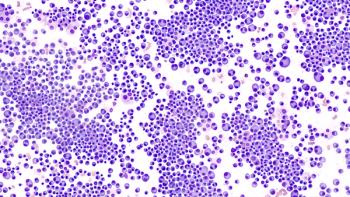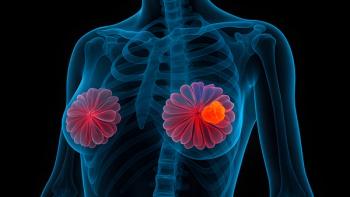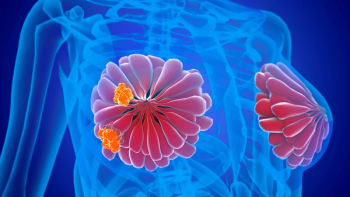
Frontline Ribociclib-Related Quality of Life Favorable to Abemaciclib in HR+/HER2- Advanced Breast Cancer
Ribociclib was associated with significantly favorable symptom-related quality of life scores compared with abemaciclib among women with hormone receptor–positive, HER2-negative advanced breast cancer.
Frontline treatment with ribociclib (Kisqali) and aromatase inhibition for hormone receptor–positive, HER2-negative advanced breast cancer was associated with better symptom-related quality of life (QOL) scores vs the combination of abemaciclib (Verzenio) and an aromatase inhibitor in the same setting. Investigators conducted a matched-adjusted indirect comparison (MAIC) using published data from individual patients treated in the MONALEESA-2 (NCT01958021) and MONARCH-3 trials (NCT02246621). The MAIC analysis was presented at the 2022 ASCO Annual Meeting.
Ribociclib was favorable over abemaciclib in reducing diarrhea, fatigue, appetite loss, and arm symptoms (such as pain or swelling in the shoulder or arm and difficulty raising the arm). Results of a prior survey identified these symptoms as having a moderate to severe effect on QOL among patients treated with CDK4/6 inhibitors.
“Ribociclib plus endocrine therapy demonstrated statistically significant improvement in overall survival [OS] across the MONALEESA [trials],” Hope Rugo, MD, FASCO, of the University of California San Francisco, Helen Diller Family Comprehensive Cancer Center, explained in a presentation of the findings. Rugo added that ribociclib, when added to an aromatase inhibitor, demonstrated the longest median OS to date of any intention-to-treat population.
CDK4/6 inhibitors plus endocrine therapy is the standard of care in the frontline treatment of patients with hormone receptor–positive, HER2-negative advanced breast cancer; however, these agents are known to have different safety profiles because of their different inhibition targets. Furthermore, because mild adverse events (AEs) can have a significant effect on a patient’s experience, patient-reported outcomes (PROs) can be useful in helping inform treatment decision-making.
In the absence of a direct head-to-head study, investigators decided to conduct a MAIC analysis of the PRO data between the 2 studies. The PALOMA-2 trial, which evaluated palbociclib (Ibrance) plus an aromatase inhibitor, could not be included because the PRO data assessed different markers than MONALEESA-2 and MONARCH-3.
MONALEESA-2 evaluated patients who had been randomized 1:1 to receiver either frontline ribociclib plus letrozole or placebo plus letrozole; MONARCH-3 compared the outcomes of patients who were assigned 2:1 to receive either abemaciclib plus nonsteroidal aromatase inhibition or the nonsteroidal aromatase inhibitor as monotherapy. Both trials enrolled patients who had received no systematic treatment for their advanced breast cancer. In addition, MONALEESA-2 included patients with measurable disease as defined by RECIST 1.1 or at least 1 predominately lytic bone lesion, and who had a treatment-free interval greater than 12 months following prior neoadjuvant or nonsteroidal aromatase inhibitor therapy. MONARCH-3 required patients to have measurable disease or nonmeasurable bone-only disease, including blastic, lytic, or mixed, as defined by RECIST 1.1, to have adequate organ function, and to have had a treatment-free interval greater than 12 months following prior neoadjuvant endocrine therapy.
Exclusion criteria included prior treatment with CDK/4 inhibitors, presence of active cardiac disease or dysfunction, and presence of inflammatory breast cancer in MONALEESA-2; prior treatment with everolimus or a CDK4/6 inhibitor, the presence of visceral crisis, lymphangitic spread, leptomeningeal carcinomatosis, or inflammatory breast cancer, and evidence or history of central nervous metastases all represented exclusion criteria in MONARCH-3.
After matching and balancing the inclusion and exclusion criteria, investigators had a sample of 354 and 493 evaluable patients from the MONALEESA-2 and MONARCH-3 trials, respectively.
Across the functional domains included in the European Organization for Research and Treatment of Cancer QLQ-C30 and BR23 questionnaire, no significant differences were detected. However, time to sustained deterioration (TTSD) numerically favored the ribociclib in terms of emotional (HR, 0.77; 95% CI, 0.45-1.32), role (HR, 0.66; 95% CI, 0.41-1.06), and social functioning (HR, 0.80; 95% CI, 0.49-1.31) in the QLQ-C30 questionnaire. Body image (HR, 0.82; 95% CI, 0.47-1.44), future perspective (HR, 0.61; 95% CI, 0.34-1.08), and sexual functioning scores (HR, 0.50; 95% CI, 0.24-1.01) all favored ribociclib in the BR23 questionnaire.
Furthermore, the TTSD analysis revealed that ribociclib scored better across 4 key symptom scales; the agent was linked to more manageable appetite loss (HR, 0.46; 95% CI, 0.27-0.81), diarrhea (HR, 0.42; 95% CI, 0.23-0.79), fatigue (HR, 0.63; 95% CI, 0.41-0.96), and arm symptoms (HR, 0.50; 95% CI, 0.24-1.01).
Abemaciclib did not perform better than ribociclib across any of these domains; however, nausea/vomiting (HR, 1.09; 95% CI, 0.63-1.86) and breast symptoms (HR, 1.26; 95% CI, 0.62-2.55) favored abemaciclib. Additionally, financial toxicity outcomes were better with abemaciclib (HR, 1.13; 95% CI, 0.60-2.14).
Study authors noted that the analysis only used published patient characteristics form the 2 studies, and unreported factors could potentially confound these data.
Reference
Rugo HS, O’Shuaghnessey J, Jhaveri KL, et al. Quality of life (QOL) with ribociclib (RIB) plus aromatase inhibitor (AI) versus abemaciclib (ABE) plus AI as first-line (1L) treatment (tx) of hormone receptor-positive/human epidermal growth factor receptor–negative (HR+/HER2−) advanced breast cancer (ABC), assessed via matching-adjusted indirect comparison (MAIC). J Clin Oncol. 2022;40(suppl 16):1015. doi:10.1200/JCO.2022.40.16_suppl.1015
Newsletter
Knowledge is power. Don’t miss the most recent breakthroughs in cancer care.
















































































